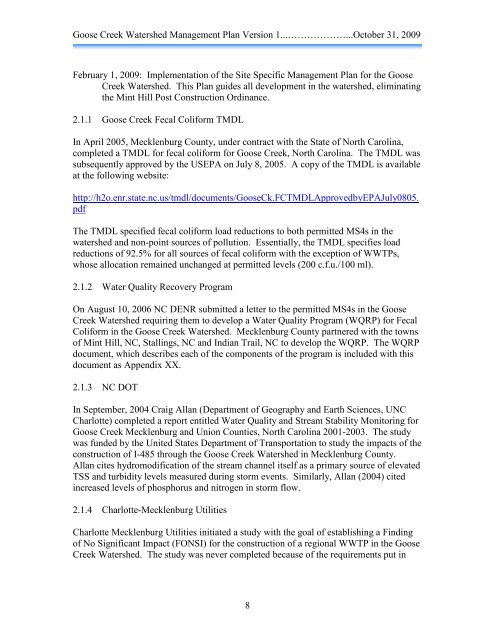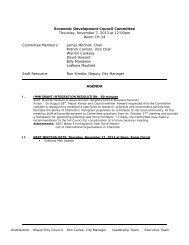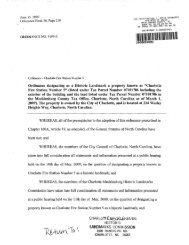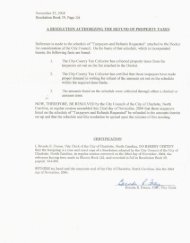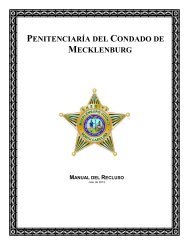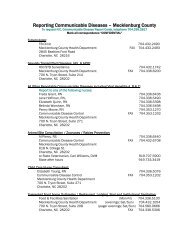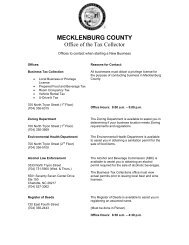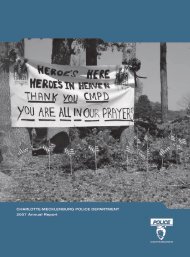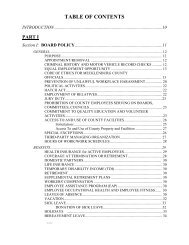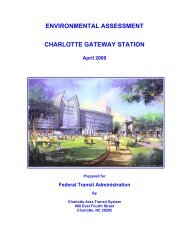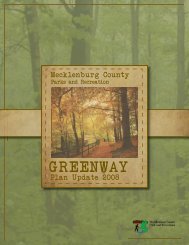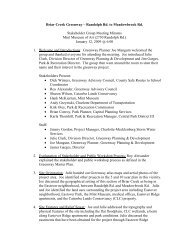Goose Creek Watershed Management Plan Version - Charlotte ...
Goose Creek Watershed Management Plan Version - Charlotte ...
Goose Creek Watershed Management Plan Version - Charlotte ...
You also want an ePaper? Increase the reach of your titles
YUMPU automatically turns print PDFs into web optimized ePapers that Google loves.
<strong>Goose</strong> <strong>Creek</strong> <strong>Watershed</strong> <strong>Management</strong> <strong>Plan</strong> <strong>Version</strong> 1...………………...October 31, 2009<br />
February 1, 2009: Implementation of the Site Specific <strong>Management</strong> <strong>Plan</strong> for the <strong>Goose</strong><br />
<strong>Creek</strong> <strong>Watershed</strong>. This <strong>Plan</strong> guides all development in the watershed, eliminating<br />
the Mint Hill Post Construction Ordinance.<br />
2.1.1 <strong>Goose</strong> <strong>Creek</strong> Fecal Coliform TMDL<br />
In April 2005, Mecklenburg County, under contract with the State of North Carolina,<br />
completed a TMDL for fecal coliform for <strong>Goose</strong> <strong>Creek</strong>, North Carolina. The TMDL was<br />
subsequently approved by the USEPA on July 8, 2005. A copy of the TMDL is available<br />
at the following website:<br />
http://h2o.enr.state.nc.us/tmdl/documents/<strong>Goose</strong>Ck.FCTMDLApprovedbyEPAJuly0805.<br />
pdf<br />
The TMDL specified fecal coliform load reductions to both permitted MS4s in the<br />
watershed and non-point sources of pollution. Essentially, the TMDL specifies load<br />
reductions of 92.5% for all sources of fecal coliform with the exception of WWTPs,<br />
whose allocation remained unchanged at permitted levels (200 c.f.u./100 ml).<br />
2.1.2 Water Quality Recovery Program<br />
On August 10, 2006 NC DENR submitted a letter to the permitted MS4s in the <strong>Goose</strong><br />
<strong>Creek</strong> <strong>Watershed</strong> requiring them to develop a Water Quality Program (WQRP) for Fecal<br />
Coliform in the <strong>Goose</strong> <strong>Creek</strong> <strong>Watershed</strong>. Mecklenburg County partnered with the towns<br />
of Mint Hill, NC, Stallings, NC and Indian Trail, NC to develop the WQRP. The WQRP<br />
document, which describes each of the components of the program is included with this<br />
document as Appendix XX.<br />
2.1.3 NC DOT<br />
In September, 2004 Craig Allan (Department of Geography and Earth Sciences, UNC<br />
<strong>Charlotte</strong>) completed a report entitled Water Quality and Stream Stability Monitoring for<br />
<strong>Goose</strong> <strong>Creek</strong> Mecklenburg and Union Counties, North Carolina 2001-2003. The study<br />
was funded by the United States Department of Transportation to study the impacts of the<br />
construction of I-485 through the <strong>Goose</strong> <strong>Creek</strong> <strong>Watershed</strong> in Mecklenburg County.<br />
Allan cites hydromodification of the stream channel itself as a primary source of elevated<br />
TSS and turbidity levels measured during storm events. Similarly, Allan (2004) cited<br />
increased levels of phosphorus and nitrogen in storm flow.<br />
2.1.4 <strong>Charlotte</strong>-Mecklenburg Utilities<br />
<strong>Charlotte</strong> Mecklenburg Utilities initiated a study with the goal of establishing a Finding<br />
of No Significant Impact (FONSI) for the construction of a regional WWTP in the <strong>Goose</strong><br />
<strong>Creek</strong> <strong>Watershed</strong>. The study was never completed because of the requirements put in<br />
8


